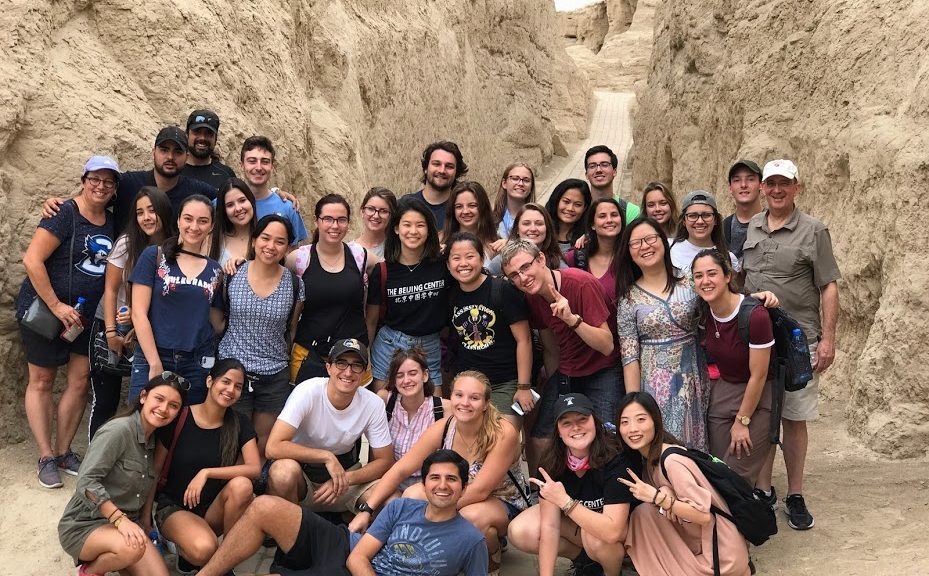
The Silk Road Excursion (END): Last Stop in the Xinjiang Province
After braving a sandstorm and riding on the backs of camels out in the desert in Dunhuang, our group traveled Turpan in the Xinjiang province for our last leg of the Silk Road excursion. I know, when we realized that we were coming up on the last few days of the trip, all of us were feeling pretty bittersweet. As you guys can probably attest from my tales in this blog, so, so much had happened to us, and we had crammed as many activities and sightseeing as we could in our short time. Two weeks had just flown by, and reflecting back upon it now makes it seem like it went by even faster than it really did.
I’ll tell you about our times in Xinjiang now, and at the end of this post, I’ll let you know some of my closing thoughts and feelings about the trip. Disclaimer: I won’t be able to summarize all of my emotions into just some words on a screen in a blog — if I claimed that I did, then I wouldn’t be doing the trip any kind of justice.
Our activities in the two cities that we visited in Xinjiang would mainly consist of having loads of free time for us students to explore. Since it was around the end of the trip, trip leaders had planned it so that our schedule wouldn’t be as jammed packed as it was during the meat of the trip. Regardless, we still had some group activities, so I’ll be talking about those mostly.
First, a tiny encouragement to you guys who are reading this blog.
Please take a moment to Google some of the events that are happening in the Xinjiang province. I think it will put our trip to this province a little bit more into perspective, and I think it will help you to understand my closing thoughts about this Silk Road excursion at the end of this post. Regardless, I am advocating it to be something that is important for you to know.
But moving on!
Turpan: Encounter with Uyghur Culture and an Ancient City
Unlike most of our previous train rides, our train to the city of Turpan in the Xinjiang province was a bullet train, not an overnight train. Bullet trains are wicked fast and incredibly smooth because they run on magnetism, so the ride was only 3 hours long compared to the 5+ hours of previous trains. The inside of the train looked very similar to the inside of an airplane, with compartments where you could put your luggage and bags in overhead. I think spent the time trying to take a nap since I was exhausted from the day’s activities (we got onto the bullet train after we came back from riding camels in the morning in Dunhuang), but the inside of the train ended up being so noisy that I couldn’t get much rest before we arrived in Turpan.
The Xinjiang province is China’s largest province to the west; its name literally translates to “new frontier.” Around 50% of its population consists of ethnic minorities, one of the largest of which are the Uyghur people, and its mostly an isolated region with deserts and grassland. In both Turpan and later in Kashgar, we experienced Uyghur culture the most, through the food, the language, as well as the types of items that we would see being sold in the marketplaces and the bazaars, like beautiful intricate and handmade rugs and scarves. The Uyghur people are a Turkic-speaking people, among the oldest Turkic-speaking peoples of Central Asia, and their culture is more related to that of the Middle East, which is why, once we got off of our bullet train in Turpan, many of us students noticed differences between the Xinjiang province and other places we visited on the Silk Road, like in the clothing of the local people and the architecture. There were many times where I forgot that I was still technically within China’s borders.
Soon after we got off of the bullet train, we met our tour guide for our time in Xinjiang, who was named Kevin. He was another one of our favorite tour guides because he was such an amusing character. He was this towering, lanky man who wore this hat that looked like a fishing boat hat and usually was swinging around a giant water bottle. He preferred to not say much, but his expressive facial expressions usually gave away what he was thinking. He was the type to make a face after someone said something rather than reply to it, which is why we students were amused to look back at him once in awhile to see what his reactions were to certain things in our environment. Kevin’s English was also had the most clearest accent out of all of our tour guides, which really surprised us, since he had only been studying the language for a few months. We praised his language abilities, since he knew how to speak Uyghur, Mandarin, and English very well. He was also just great company to have, and he himself acted like a TBC flag because he was so tall.
Kevin led us through the security of the train station, and we got onto our bus to go to have dinner at a Uyghur family’s house, a family that Kevin knew very well. On the bus, tuckered out from our bullet train ride and our early morning activities in Dunhuang, I watched as we drove along Turpan’s dusty and eerily empty streets.
By the time we got to our dinner location, it was still pretty light outside. We were invited into the venue, which was outside but was surrounded by tall wooden structures covered by grape vines and leaves. There were enough that it basically created a ceiling for us.
Wait, grape vines?
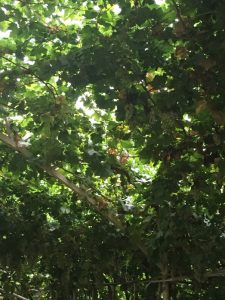
Yup! Nearly every household in the Xinjiang region is involved in grape production, so having your own homegrown grapes was pretty common there! Kevin said that the grapes in the venue were free for the picking, and so while we waited for dinner to be cooked, a bunch of us wandered around the area, picking grapes straight off of their vines. They were very sweet and crisp, and they were a nice treat before dinner.
After awhile, we were summoned back to the main room that had a few white circle tables set up with a turntable in the middle. For the next hour or so, we were served absolutely delicious Uyghur food, which included grilled lamb skewers (which was probably my favorite part of the dinner) and fried rice, noodles, a tomato and onion salad, and more. My mouth is just watering as I think about it. In addition, we were also given some warm tea, but it was served in a bowl rather than a cup!
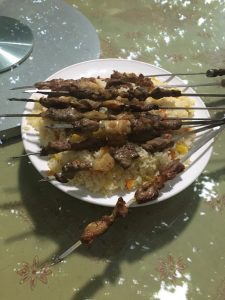
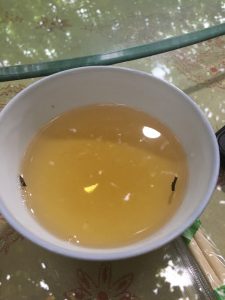
Once we were finished with dinner, the family played some traditional Uyghur music for us, and they also performed some Uyghur dances for us as well. The woman was dressed in a beautiful red and black dress, and the man was wearing a red and black man’s dress with trousers and boots. It brought smiles to all of our faces to see a mesmerizing performance, filled with quick spins and twists of the wrist. At one point, the woman balanced a couple of bowls on her head while she kept dancing and spinning! In fact, we had no idea that those bowls had been filled with water until she took them off of her head and poured the water into a different bowl! It was ridiculous!

It wasn’t long until we were invited up to the stage to dance with many members of the family. We made a circle, and music played while we laughed and cheered as some of us students, one by one, were invited to dance with them in the middle of the circle. The way how they were invited were usually really cute — one man offered a bouquet of flowers to a student. It filled me with joy that night to interact with a culture that so warmly welcomed us to have fun with them. The dancing and singing only lasted for a short while before we had to say our goodbyes to get back onto the bus and check into our hotel for the night.
The next day, we had a quick breakfast at the hotel before we got back onto the bus and headed to the Jiaohe Ancient City Ruins.
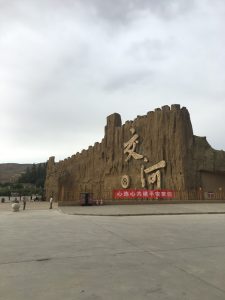
The city is located at the top of a plateau-like geological structure, with cliffs that are around 98 feet above ground, which gave the city a natural defense. Its buildings were built using what was available in the arid environment — clay. It dates before the 8th century, existing during the time of the Han Dynasty, before it was destroyed by the Mongols and subsequently abandoned. Turpan has a dry atmosphere and extremely minimal rainfall, which is why the structures were so well preserved. Kevin gave us a tour of the city, leading us through old roads that winded like a snake through the city, as we stared in awe at the strangely beautiful, still-standing buildings made out of clay and mud, literally thousands of years old. To think that we were walking along the same paths as people from thousands of years ago was quite unimaginable.
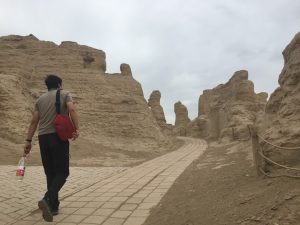
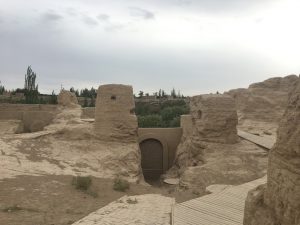
At some point, Kevin lead us downstairs into an actual ancient house for us to explore. Not a replica of the house, but the actual house. We were able to touch its rough clay walls, still standing strong due to Turpan’s dry climate, and we rested for a little bit on the step before we moved on.

The weather that day was really cool, with a nice breeze. It was a cloudy day, but the clouds were kind of just scattered in the sky with flickers of sunlight shining through them, creating a really cool sight with the ancient city ruins in the horizon. Actually, while we were there, there was a tiny bit of a rainfall, which Kevin thought to be peculiar, since it had not rained for months. We thought it to be a lucky sign to welcome us to the region.
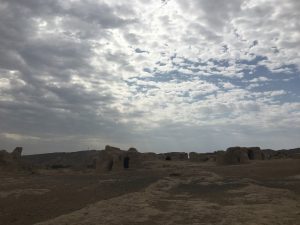
Most of the rest of our time there was spent taking… you guessed it, some really neat photos!
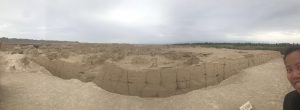
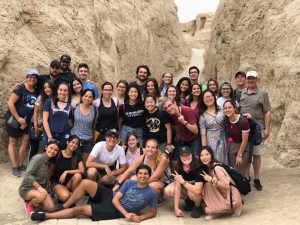

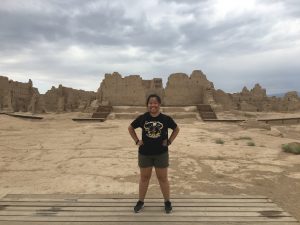
After seeing all of the city ruins, we received some great news (not being sarcastic, there). So original plan was for us to take a 3 hour drive to a train station in Urumqi, the capital of the Xinjiang region, in order to take our last overnight train get to Kashgar, our last stop on the Silk Road. However, one of our trip leaders was able to get us train tickets from Turpan to Kashgar directly, cutting down at least 6 hours off of our travel time. The original train was going to be 18 hours, so you know that we all rejoiced when 2 hours of that ride was removed.
Kashgar
We arrived in Kashgar the following day around 10am. Because we were so far out west, the time zone seemed to be different than usual since it didn’t turn dark outside until around 8pm, but because there are no time zones like how there is in America, the time was the same as it was in Beijing. This caused some confusion for our circadian rhythms — it would be 8pm at night, but it would be perfectly light outside, so many of us would fall into the trap of going to bed really late at night.
The population of Kashgar, like many cities in the Xinjiang province, is dominated by the Uyghur minority. The city, like how it was during the days of the Silk Road, is still a busy market town despite rapid modernization. Close by was what was called “Old City,” which is a long street that was lined with buildings that had market stands selling all kinds of trinkets. Most noticeably, Kashgar is known for selling its fuzzy soft rugs and its colorful patterned scarves in its markets, as well as its Uyghur-style street food.
Our hotel was quite extravagant and would be our home for at least two days while we explored Kashgar. What I found the most amusing about our Kashgar hotel was that every time anyone from our group would come back to the hotel and went through security, the security guards would cheerfully greet us in English. I thought it was a friendly touch and allowed for us to calm our nerves a little bit from the day.
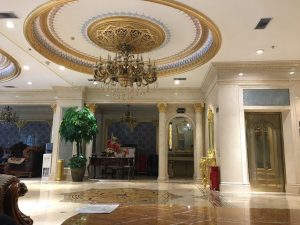
Kashgar was where we got most of our exploration freedom, so the days spent in Kashgar blur together. You’ll have to forgive my fuzzy memory!
Once we checked into our hotel, we walked over to the nearby mosque and was given a tour. Unfortunately, and understandably, we were not allowed to take pictures while inside the mosque, but I can tell you that it was gorgeous and quite different from the Chinese-styled mosque that we visited in Xi’an. This mosque had no remnants of any kind of Chinese architecture.
Afterwards, we took a bus to visit the Aba Khoja Mausoleum, which is a perfect example of Islamic architecture in China.
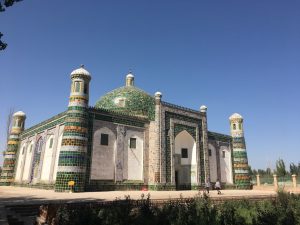
It is the burial place of Aba Khoja, who was a local ruler, and it is also said to be the burial place of Ikparhan. Ikparhan, as we learned, was known to be the “fragrant concubine,” because of her distinctive, lovely scent. She was taken from her home by an emperor and kept refusing him until her death. Her scent is thought to be the result of a certain sap from a certain tree that Uyghur women use in their hair in order to prevent balding and to make their hair soft. There was such a tree around the mausoleum, where we were told the story of Ikparhan.
Once we got back to around the area by our hotel, we were released for free time for food and for any exploration we wanted to do.
The street that our hotel was on was ridiculously close to cute shops that my friends and I went into multiple times to buy stationary amongst other things. There were also delicious foods and beverages sold in the area as well. My personal favorite beverage that we got multiple times was this sour yogurt-y drink that was sold in what looked like a tiny mini bar outside.
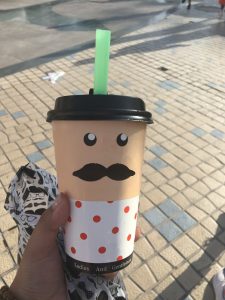
The bartender would chip off some ice from a literal block of ice into a bowl and then put some kind of syrup into the bowl before mixing it by tossing the liquid contents all together. He would do tricks by tossing the liquid really high into the air before catching it all cleanly into the bowl again, doing this multiple times before he poured it into a cup and handed it to us. For less than a dollar we got a delicious refreshing drink and some entertainment!
During another one of the days, we visited that “Old City” that I had mentioned.
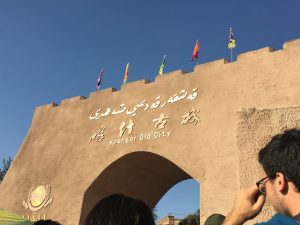
This was basically a very long street that sold trinkets and street food galore. You were allowed to bargain for the things being sold, making your purchase feel a lot more… meaningful, than usual. Now that I’m back in Beijing, where everything is a set price again, I’ve been sad that I can’t bargain for a better price.
That’s besides the point, haha.
The buildings were different from all of the Chinese architecture that we had seen before on the Silk Road, taking more of a Middle-Eastern style of buildings.
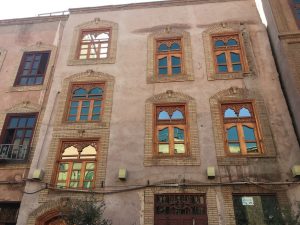
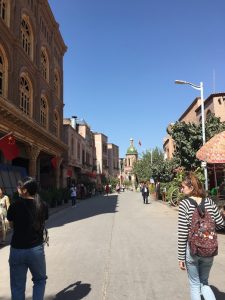
And the streets like the one pictured above continued for what seemed like forever. It always smelled like something being grilled, whether it was fresh naan bread or some sort of meat. My favorite street food was definitely the kebobs, or this empanada-type dough package of meat that was crispy and filled with meat and onions. Well, I’ve discovered that any kind of street food is my favorite type of street food (mostly because it was ridiculously good, and it was really cheap!)
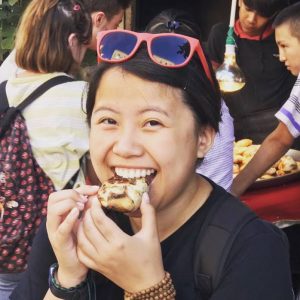
Another day, we visited one of the largest bazaars in Kashgar: the Sunday Great Bazaar. It’s usually at its busiest on Sundays, which is exactly why we didn’t go on a Sunday. We were basically set loose for a few hours to browse all that each of the stands had to offer and to bargain, bargain, and, you guessed it, bargain. My friend group all were successfully able to bargain our prices to at least 50% cheaper than the original price, much to our delight. I unfortunately didn’t get much pictures of this bazaar since I was too busy shopping around (oops!).
A bunch of street food and a lot of bargaining later, it was soon time for us to travel all the way back to Beijing. We had gone over 2,000 miles west from our campus in Beijing, and there was no way we were going to travel all of those miles back home in a single day by train. So, we took the next best form of transportation. An airplane!
Our plane ride was about 6 hours, and we, thoroughly exhausted from our adventures on this Silk Road trip, settled in as we readied ourselves for a more routine schedule back in Beijing.
During those 6 hours, I personally reflected on the trip (while I doodled some pictures, which is one of the ways how I tend to decompress and just absorb things that are happening to me and around me. I had bought a sketch book and a nice pencil in one of those cute shops in Kashgar), and here is where I discuss my overall final thoughts.
Some Final Thoughts
First, about a year ago, I would have never, ever, thought that in my lifetime I would take selfies with the Terracota Warriors and get buried in the desert in the middle of a mini sandstorm. I never thought that I would see the landscapes that I saw and feel the spiritual power of some of the locations. I didn’t think that I would be able to tell these tales about traveling along something as historic as the Silk Road, and yet…
I’m telling them now, to you all.
What I felt traveling across China to experience everything that we had experienced are still hard to put into words. I can only say “happy,” “joyful,” “amazing,” and other similar adjectives so many times before those words just cannot describe what I remember about those emotions anymore. So I won’t bore you with such words and phrases.
But at least I can say that, inside of my memories and myself as a person, I can carry the true meaning of my memories and my emotions with me. Even if I can’t perfectly describe it, that’s perfectly fine. Perhaps one of the most important lessons that I’ve learned on this trip is that you don’t need to put words to a feeling all the time, especially if they’re all jumbled and complex. What matters more is what those emotions mean to you, what you will gain from them, and what you can give to others as a result of them.
Many of the trip leaders had said that even though we all were taking the same trip together, all of us would have a unique personal experience on the Silk Road. I can kind of better understand what they meant by that, now. What we’ve gained from the experience is unique to each of us, and I think that’s such an impactful thing. I’ve been given this an amazing life experience, and that’s priceless. For the gift of exploring my own self while being submerged in various cultures and histories, I want to express how grateful I am to have had this incredible opportunity. There was no way I could have prepared myself for such an experience, but it would be an understatement to say that I’m glad that I, and my peers, took the dive.
One of the trip leaders, a professor who was a brilliant resource to us during the trip (I have the pleasure to have him as a professor this semester), said something to us on our way to our very first overnight train to Xi’an. It has continued to resonate with me, even now when it’s been a few weeks since we’ve returned to Beijing. I think it summarizes the trip very nicely and captures the essence of what I’ve been trying to say in this jumble of final thoughts.
“Travelers don’t always know where they’re going, but tourists don’t know where they’ve been.”
And boy, do I remember where I’ve been.
I want to thank everyone on the Silk Road excursion for giving me such rich and beautiful memories that I’ll remember for the rest of my life. The sites of our trip were amazing, yes, but honestly, it was the people that I traveled with and shared the experience with that made the trip that much more incredible. The friendships that we forged together and the travel that we embarked on together in this rich and amazing country are precious times that we would have never been able to do if it weren’t for this program, The Beijing Center. So thank you, everyone at TBC!
I also would like to thank the Travel Bible (aka the Silk Road Trip Itinerary) for providing such detailed information about all of the places we traveled to for us while we were on the trip and for this blog so that I could best share my tales with everyone back at home.
I hope you all enjoyed reading about the Silk Road excursion. I apologize for my rambling near the end there, but I definitely enjoyed reflecting back on the trip and locking those beautiful memories away in my heart. I’m glad that I pushed myself and took the time to write about it. I won’t ever stop talking about it, even well after I’ve returned to America. Because of the trip and because of the people on the trip, I’ve grown and developed yet again, and I can never express enough thanks for that.
But the end of this Silk Road series doesn’t mark the end of my blog! We still got the rest of the semester to go, so stay tuned for some future blogs about life in here in China! I got lots to say! 🙂
Until next time~
-Justine